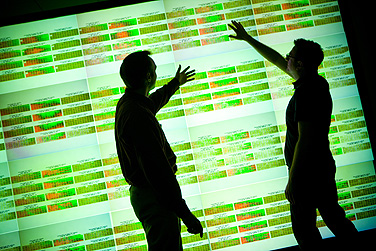News
Oishei grant expands bioinformatics hub

A generous grant from the Oishei Foundation will help UB bring new researchers to Buffalo Niagara. Photo: DOUGLAS LEVERE
-
 Print
Print -
 Comments
Comments
-
“This expertise is critical to our efforts to understand human disease at its most basic, molecular level.”
A major grant from the John R. Oishei Foundation will help UB’s New York State Center of Excellence in Bioinformatics and Life Sciences expand its bioinformatics and computational biology expertise on the Buffalo Niagara Medical Campus (BNMC).
The foundation funding, totaling $850,000 over two years, will help fund new tenure-track faculty members and computational support staff in the School of Medicine and Biomedical Sciences. These researchers will have offices and laboratory space at the Center of Excellence, which houses the university’s core supercomputing and genomics facilities, both of which have benefited from significant upgrades since 2010.
The growth of the bioinformatics hub complements UB’s plan to relocate the medical school to the BNMC, a move that will bring students and faculty closer to research and clinical partners, such as Kaleida Health.
“This generous support from the Oishei Foundation helps to advance the objectives of the UB 2020 plan for academic excellence,” says Michael Cain, vice president for health sciences and dean of the School of Medicine and Biomedical Sciences. “The expansion of the bioinformatics hub will contribute to a vibrant medical campus and improve Western New York’s ability to conduct translational research, moving scientific discoveries from laboratories to practical applications to improve human health.”
Robert D. Gioia, president of the Oishei Foundation, says the Center of Excellence has done an outstanding job “securing the resources necessary to build and equip a state-of-the-art facility, and we’re pleased to support the key academic professionals needed to staff it.”
“We fully expect that this support will enable the Center of Excellence to retain computational work that was being sent elsewhere and to build a core of local projects, further expanding the promise of the BNMC.”
The new recruits the Oishei Foundation is helping to fund will be experts in computational biology and bioinformatics, a field that combines computer science and biology to better understand disease mechanisms, resulting in new diagnostic tests and patient treatments.
Their research, combined with the ongoing work of UB’s Department of Biostatistics, will provide valuable expertise to a variety of researchers and companies in the Buffalo area.
As UB’s research capacity in bioinformatics grows, area scientists and firms will continue to partner with the university on projects that will fuel growth of the region’s life sciences industry. Expanding the university’s capabilities also will position Buffalo Niagara to mine and analyze data for collaborators around the country and world with the goal of explaining how given sets of genes or proteins are involved in disease.
“This expertise is critical to our efforts to understand human disease at its most basic, molecular level,” says Norma Nowak, director of science and technology at the Center of Excellence and a UB faculty member. “It enables us to diagnose and define disease by the causative molecular alterations that lead to the symptoms traditionally utilized to make a diagnosis.
“It is a vital piece of the puzzle that the university—through both the Center of Excellence and the new Clinical and Translational Research Center under construction in downtown Buffalo—is working to assemble with partners including Roswell Park Cancer Institute, Hauptman-Woodward Medical Research Institute and the region’s life sciences industry,” adds Nowak, who led efforts to apply for the Oishei grant.
A stronger bioinformatics hub will help attract additional talent to Buffalo Niagara, creating opportunities for students to engage in cutting-edge science and supporting life sciences recruitment, professional development and the implementation of large, multi-institution research projects.
The Oishei funding complements recent upgrades to UB’s core supercomputing and genomics facilities. Last year, the Center for Computational Research (CCR) underwent a more than $9 million expansion that allowed the facility to more than quadruple the power of data processing—to 60 to 70 teraflops—and increase electronic memory by more than 20 times—to 600 terabytes of storage capacity.
Additions included the installation of novel computing architectures that enable both data-driven science and computationally demanding modeling and simulation. Money for the improvements came from competitive grants that the National Institutes of Health (NIH), National Science Foundation and New York State Energy Research and Development Authority awarded to UB faculty.
More recently, the Center of Excellence’s Next-Generation Sequencing and Expression Analysis Core Facility acquired an important new piece of equipment: an illumina HiSeq 2000, an instrument so powerful it can sequence a human genome in a week.
The $700,000 HiSeq instrument, which arrived in January, can facilitate projects including whole-genome and candidate region sequencing, transcriptome analysis, small RNA discovery, methylation profiling and protein-nucleic acid interaction analysis on a genome-wide scale. A grant from the National Center for Research Resources at the NIH funded the HiSeq purchase.

Reader Comments